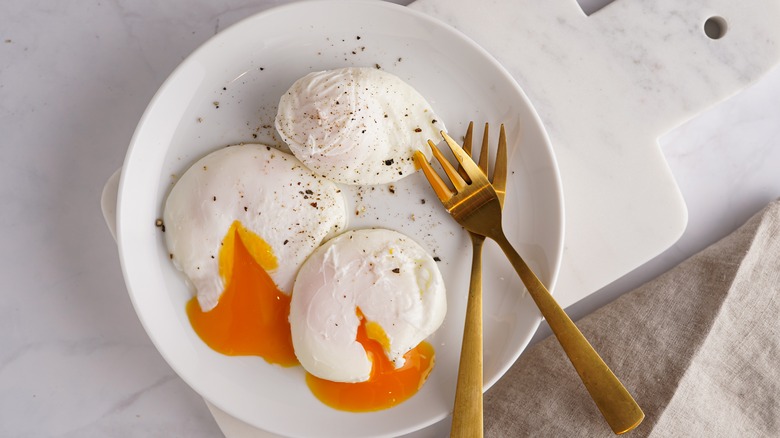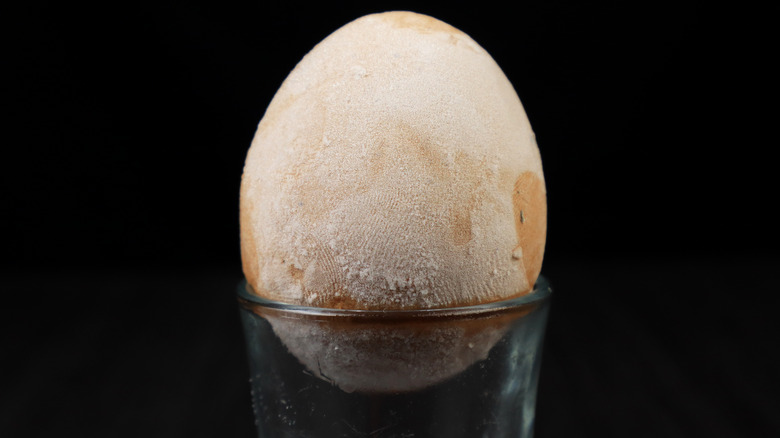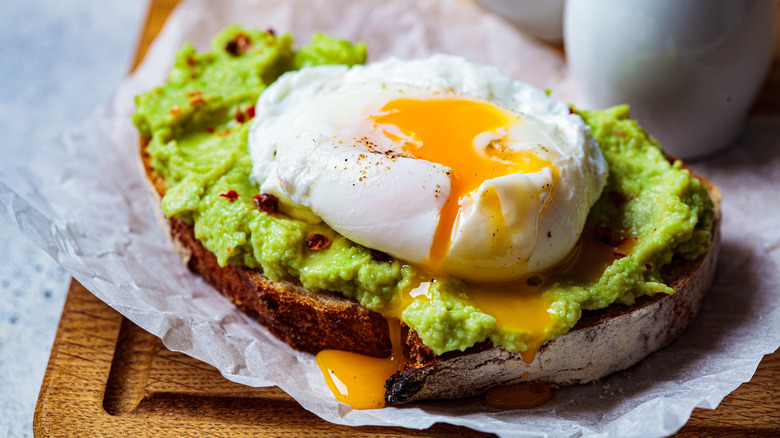The Best Poached Eggs Are Frozen Before They Hit The Water
It can be easy to make mistakes when poaching eggs, and the food may seem a little intimidating. But there's one easy way to ensure your eggs come out perfectly shaped. Before you begin the poaching process, allow the eggs to freeze for about an hour. While it may seem counterintuitive to freeze food before cooking it, this can actually benefit the poaching process.
The colder your eggs are, the better they'll hold their shape. The egg white's proteins are more tightly constricted in cold temperatures. As they heat up, they become a little looser. Keeping those proteins tightly together will help the eggs retain a more rounded shape as they cook up in the water, preventing any flyaway whites, so your poached eggs look as good as they taste.
It is inadvisable to freeze eggs inside their shells. If the shells crack, harmful bacteria may creep in. If you're going to leave the eggs in the freezer longer than an hour, you can crack the egg into a freezer-safe bowl or airtight container. Then, when you're ready to cook them up, you can simply pop them out and place them into your simmering water.
Frozen eggs should be cooked a little longer
The poaching process is the same with frozen eggs as it is with eggs right out of the carton: Bring a pot of water to a boil on the stovetop, reduce to a simmer, and pour the egg in. But because of the temperature difference, colder eggs may not cook as quickly. While fridge-temperature eggs will typically take around three to five minutes to poach properly, colder eggs may need a little longer in the water.
While four to five minutes may be sufficient if you like your yolks runny, seven minutes may be necessary to get them to set up more. If you are a fan of runny egg yolks, however, this hack may be especially useful. The prolonged cooking time can set up the whites without overcooking the yolk inside.
This does come with a small downside, however. You'll need to find a balance between completely cooking the egg yolk and preventing the whites from overcooking. If the egg whites are cooked for too long, they may take on a rubbery texture, which could make them slightly unpleasant to eat.
Other ways to perfectly shape a poached egg
There are plenty of other tips for poaching eggs to ensure they come out perfectly formed, too. Fresh eggs are more likely to have thicker whites that hold up better during the cooking process. So while refrigerated eggs are safe to eat for a few weeks, you're better off buying a brand-new carton if you plan to poach a few.
Additionally, some egg enthusiasts suggest adding a little vinegar to your water before your eggs go in. The acidic liquid accelerates the egg's proteins solidifying, so they will finish cooking more quickly — before the whites have a chance to separate. Once the vinegar is in, you can gently stir the pot prior to adding your eggs in, too. This motion will encourage the egg whites and yolk to swirl together as it all cooks up.
There are also a couple of kitchen tools that you can use to aid the formation. If you crack your egg into a small bowl, you can tilt the bowl into the water. Once the whites begin to cook in the contained space, you can pour the egg out and remove the bowl. Then, when you're ready to remove the eggs, use a slotted spoon to drain the excess water off the egg without having to wiggle it around.



